Navy 'Blue Sharks' Search For 'Whales'
MCAF Iwakuni Torii Teller 1961
Story By: SSgt Bob Wills
Photos By: Sgt Dan Brereton
Contributed by Richard Young
"Navigator, this is Radar. I have a contact, bearing 032 degrees at 15 miles."
"Roger Radar--break. Flight--Alter heading starboard to 032 degrees to investigate radar contact."
"Range to contact two miles."
"Roger Radar, I have him visually" .....
A "shark" has located its prey-- the "whale."
The "whale" is a submarine, spotted by the "Blue Sharks" of Navy Patrol Squadron-Six, a unit responsible for detecting and tracking submarines which enter a 3,000-mile sea front extending from Japan to the Philippine Islands.
"Skippered" by Cdr. Edward F. Leonard, VP-6 is one of four Navy Patrol units attached to Task Force 72, U.S. Taiwan Patrol Force. These squadrons serve as the eyes and ears of the U.S. Seventh Fleet keeping constant watch over international waters stretching from Siberia to North Vietnam.
Temporarily based at MCAF, Iwakuni, VP-6 is attached to Fleet Air Wing-Six and joins VP-50 in conducting all-weather anti-submarine operations in certain assigned areas.
Unlike VP-50, a permanent unit at MCAF, VP-6 rotates between TF-72 and NAS Barber's Point, Hawaii with its counterparts, VP-22 and VP-28.
Fulfilling its mission at Iwakuni, the squadron flies eleven P2V Neptunes between 700 and 900 hours monthly. This includes operations, training and maintenance flights involving about 135 of the unit's 297 personnel.
A typical crew consists of four officers, two pilots and two navigators; and eight enlisted technicians, a plane captain, two radiomen, two radarmen, two ordnancemen and a bow observer.
Versatility of the men assigned to each flight crew enables rotation of duties during an exhausting, 12-hour sub-hunting flight.
"Exhausting is a mild word for these trips," explains one crewmember. "After years of research, they finally came up with a foam rubber seat that somehow turns to beer cans after you sit on it for three hours."
Serving as a member of a flight crew is not all peaches and cream; this is apparent after a look at the squadron's revolving 11-day schedule.
Returning from a half-day flying mission, the crewmen take one day off. For the following nine days they join a duty section, standing squadron watches, participating in unit training and pulling ground maintenance on aircraft. The day before a scheduled flight the crew is assigned as stand-by section and remains on call throughout the day.
Since a crew is only as good as the plane it flies, maintenance of the eleven P2V's is a never-ending task in VP-6.
The P2V is a giant-sized bird to care for .. it has a wing span of 104 feet, engines which produce over 10,000 H.P., over 400 buttons and switches, and 3,000 miles of wiring. Keeping the Neptunes in peak operating performance is the arduous task accomplished by the squadron's Maintenance Department, which consists of nine divisions and about 100 ground personnel, who work an eighteen-hour day, seven days per week.
Fifteen maintenance man-hours are pulled on each aircraft during pre and post-flight inspections. Other maintenance chores include a daily inspection, a thorough special check every 12 working days, and an intermediate or major inspection every two months.
Every twenty months the aircraft receives a progressive re-work, during which time the engines are completely overhauled.
The vast majority of maintenance personnel in VP-6 have been or are under training as crewmembers.
Each of the VP-6 patrol planes is supported by approximately six men on the ground. This group includes personnel in operations, administration and supply departments.
Working as a skilled Navy team, the "Blue Sharks" of VP-6 fulfill a vital mission that helps preserve peace and security in the Far East.
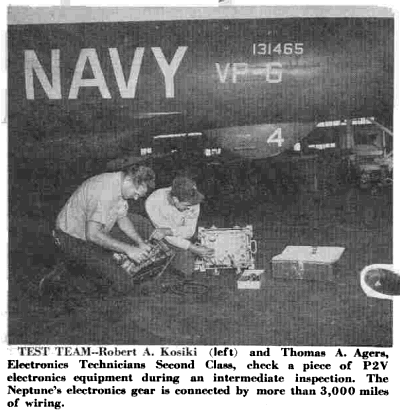
TEST TEAM--Robert A. Kosicki (left) and Thomas A. Agers, Electronics Technicians Second Class, check a piece of P2V electronics equipment during an intermediate inspection. The Neptune's electronics gear is connected by more than 3,000 miles of wiring. |
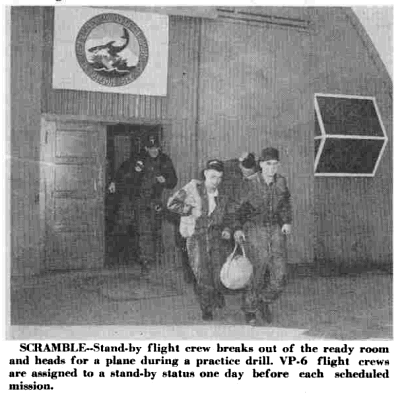
SCRAMBLE--Stand-by flight crew breaks out of the ready room and heads for a plane during a practice drill. VP-6 flight crews are assigned to a stand-by status one day before each scheduled mission. |
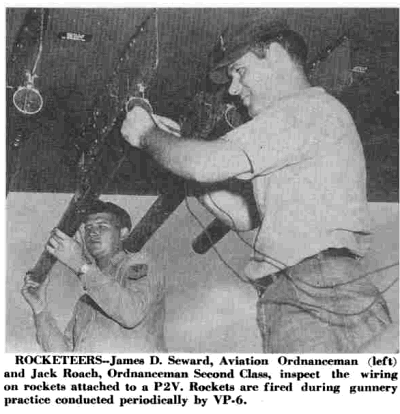
ROCKETEERS--James D. Seward, Aviation Ordnanceman (left) and Jack Roach, Ordnanceman Second Class, inspect the wiring on rockets attached to a P2V. Rockets are fired during gunnery practice conducted periodically by VP-6.
|
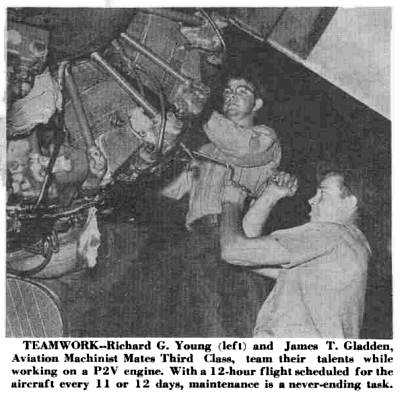
TEAMWORK--Richard G. Young (left) and James T. Gladden, Aviation Machinist Mates Third Class, team their talents while working on a P2V engine. With a 12-hour flight scheduled for the aircraft every 11 or 12 days, maintenance is a never-ending task. |
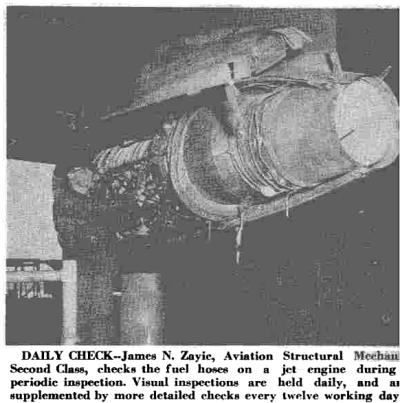
DAILY CHECK--James N. Zayic, Aviation Structural Mechanic Second Class, Checks the fuel hoses on a jet engine during a periodic inspection. Visual inspections are held daily, and are supplemented by more detailed checks every twelve working days.
|
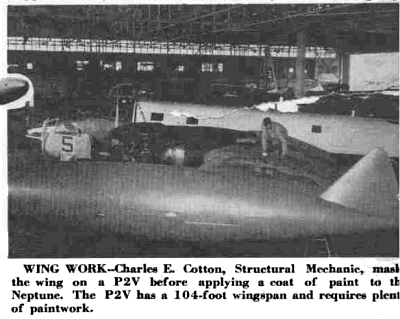
WING WORK--Charles E. Cotton, Structural Mechanic, masks the wing on a P2V before applying a coat of paint to the Neptune. The P2V has a 104-foot wingspan and requires plenty of paintwork.
|
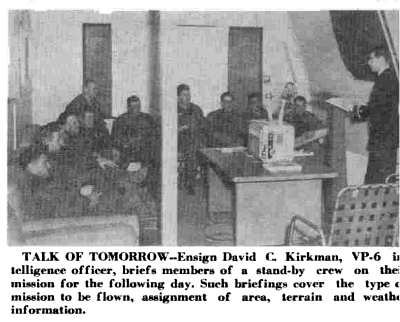
TALK OF TOMORROW--Ensign David C. Kirkman, VP-6 intelligence officer, briefs members of a stand-by crew on their mission for the following day. Such briefings cover the type of mission to be flown, assignment of area, terrain and weather information.
|
|